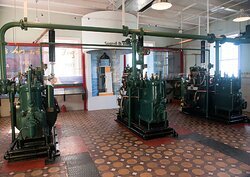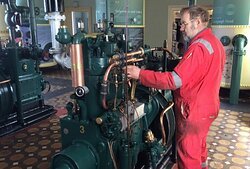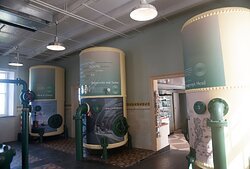Engine Room
 The three engines have been fully restored
The Engine Room contains the three large K series diesel Kelvin engines, which provide the power for the foghorn. These impressive machines were installed in the spring of 1952, replacing the outdated Crossley engines, which ran on paraffin.
The three engines have been fully restored
The Engine Room contains the three large K series diesel Kelvin engines, which provide the power for the foghorn. These impressive machines were installed in the spring of 1952, replacing the outdated Crossley engines, which ran on paraffin.
Visitors who have purchased a ticket will begin their journey through Sumburgh Head’s past here - after purchasing a ticket next door, in what was the fuel storage area, and is now the Ticket Office and Gift Shop.
The room has been restored back to its former glory with a full overhaul of the engines and the inclusion of the sights, sounds and smells of a typical Lighthouse engine room, to accompany the interpretative information panels.
Detailed interpretive panels tell the story of the Lighthouse as an historic guardian which has enabled mariners to navigate the dangerous waters around Sumburgh Head since 1821. Explore the importance of the Lighthouse historically and architecturally, and read all about the changing technology of the light itself.
 Brian Johnson tends to the restored engines
The engines themselves have been stripped down, cleaned and rebuilt by ex-lighthouse keeper and current lighthouse engineer, Brian Johnson, who can be viewed in the video below, starting the three diesel engines below for the first time since 1987.
Brian Johnson tends to the restored engines
The engines themselves have been stripped down, cleaned and rebuilt by ex-lighthouse keeper and current lighthouse engineer, Brian Johnson, who can be viewed in the video below, starting the three diesel engines below for the first time since 1987.
The Engine Room building, and attached Principal Keepers cottage, which now houses the RSPB Scotland office, was built in 1905/06 at the same time as the Foghorn Tower was constructed. The addition of the Foghorn and the engines required to power it, required an additional Keeper to be stationed at Sumburgh Head. Needless to say, the Principle Keeper was entitled to the brand new house!
 Receiver tanks which store compressed air display information on the perils of the sea around Sumburgh
The large receiver tanks in the Engine Room are used to store the compressed air required to sound the Foghorn. Information panels on here highlight the dangers that are ever present to mariners around Sumburgh Head, even in modern times.
Receiver tanks which store compressed air display information on the perils of the sea around Sumburgh
The large receiver tanks in the Engine Room are used to store the compressed air required to sound the Foghorn. Information panels on here highlight the dangers that are ever present to mariners around Sumburgh Head, even in modern times.
Modern technology plays an important part in safety at sea, and Sumburgh Head is part of a network of 14 ground-based reference stations which provide transmissions for Differential Global Positioning Systems (DGPS). This is a satellite system which is provided to mariners for navigation purposes. Sumburgh also transmits messages to ships with details of the light name and position, which is an added safety mesaure for vessels who are not famliar with the area. Visitors can see this Automatic Identification System (AIS) in action in the Engine Room, where all vessels in the seas around Sumburgh Head can be tracked live on screen.
MAKE THE MOST OF YOUR VISIT WITH YOUR SMART PHONE
 |
We have had to block off interactive elements in the Visitor Centre for hygiene reasons as they require you to touch screens or objects. Where possible we have replaced these with QR codes. Simply logon to our free wi-fi (SIC Guest - no password required). Open the camera on your smart phone and hold it up to the QR code. A notification will then appear asking you if you want to open a weblink. Tap on this and it will take you straight to our website where we will have further information taken from the interactive. |
SUPPORT US
 |
We receive no public funding and rely entirely on the generous support of our visitors to keep the site staffed and maintained, the buildings and collections cared for and to welcome visitors through our doors. Please support us by donating now and recommending our site to your friends. |

